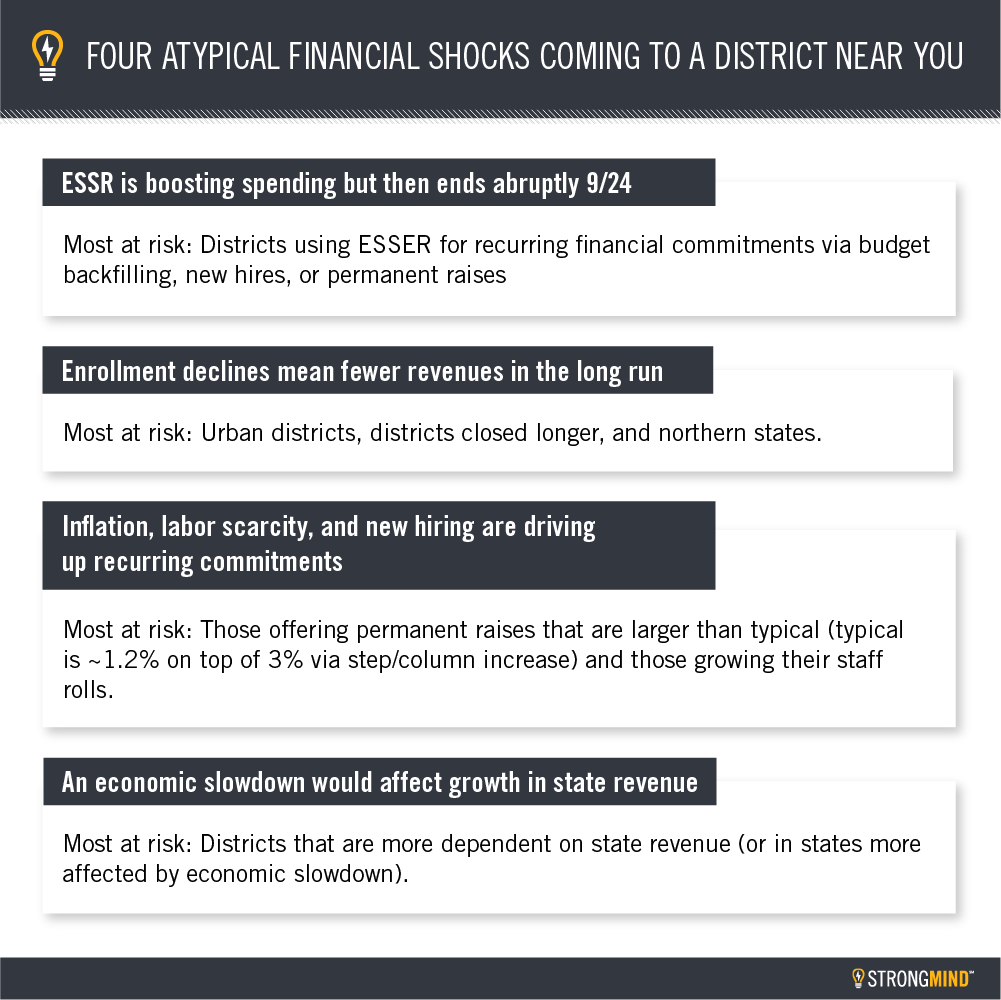Susan Gentz, blog author, is the founder of BSG Strategies and an education policy expert working to educate district leaders on funding, flexibility, and opportunities for innovation in state and federal policy.
As the first deadline for spending education stimulus funds approaches, both from the Elementary and Secondary Schools Emergency Relief (ESSER) and the Governor’s Emergency Education Relief (GEER) fund it is important to take a look at two things: how the funds were and were not spent.
What went well?
The jury is still out. The beauty of these funds is that there are new processes, tools, and programs being evaluated. The hard part is, there is not yet enough data to truly understand what were and were not good uses of these dollars.
Some good things:
Brought Hope: Education advocates have long lobbied for more funds for districts. These stimulus dollars brought hope and smiles to the faces of district leaders and educators across the nation. Some of the largest districts saw incredible percentages added to their annual budgets. For example, district leaders were quoted as saying “scarcity won’t be the ruling principle.” The influx these funds provided was unprecedented. For example, a school district in New York with an enrollment of around 3,000 is estimated to receive $2.7 million dollars, an increase of around 4% of their annual operating budget which is just over $64 million. Another district in New Jersey received $20 million which was around a 12% increase of their annual operating budget of $165 million. These numbers were incredible, and with those numbers came a morale booster in a time of such hardship across the globe.


Community stakeholders became more involved: Community engagement has also been long talked about in education, and to some extent has been done since the inception of the United States Department of Education under President Lyndon B. Johnson. Many times, however, community engagement meant some town hall meetings with stakeholders who had the availability to attend at certain and specific times. This often meant the input from underrepresented communities, groups, parents, and students did not provide feedback on decisions made by the district. Stakeholder engagement was a big part of creating a plan to spend the stimulus funds.
The Department of Education put out recommendations and guidance to engage stakeholders and states and districts took that to heart. Districts across the country have created or are creating Parent hubs to allow for more feedback opportunities and to better understand the needs of students.
Social-emotional learning and mental health were brought to the forefront. Student well-being and mental health have been in the news for years, but the stimulus funds put funding where the talk was. Governors took a keen interest in student well-being, especially as more violence comes to light. In fact, the National Governor’s Association followed the journey of six states and their plans to address student mental health needs. The NGA reports that “Two common themes have emerged from the work of these states as being foundational to improving student, family and school staff well-being: cross-agency collaboration and family engagement. Each state has a unique approach and context for supporting students’ holistic needs- read what each state is doing here.
What Could Have Gone Better?
As Round I funding comes to a close it will be interesting to see how much funding each state has left unobligated by the required date. There will be many questions of why that is. Perhaps the funds are all obligated but the labor shortage and inflation made it impossible to purchase or build what the original plan was. The supply chain had a huge impact on supplies being delivered and installed in a timely fashion and some of these issues caught decision makers by surprise. Aside from these issues, there were bureaucratic issues that also slowed spending.
Some not so good things:
Administrative processes. The timeline for spending was delayed for many right off the bat with states failing to allocate the funds quickly for districts to spend. Edweek reported that, “districts in Florida and Missouri waited nearly a year for their states to grant them access to their entire allocations. And districts in Arizona and Michigan endured months of legislative wrangling over whether to use federal relief funds to penalize schools that stayed in remote learning mode to mitigate the spread of COVID-19.”
There were other dollars available through other agencies, such as the Federal Emergency Management Agency (FEMA) took a long time to provide reimbursements. Districts were swimming in paperwork, and most with data systems that were not able to help lessen the burden for reporting purposes.

The entire process for spending the funds has been a burden for districts. The purchase order process seems so antiquated in these situations. The idea that a district needs to submit a P.O. before the funds are then freed up adds an extra layer of time to get the ESSER dollars out the door. This process can lead to several human errors, wrong items purchased, and essentially halt something that needs to be done quickly, efficiently, and accurately. Automated purchasing processes would have helped lessen many burdens for districts.
Several districts also planned to use these federal dollars to hire a lot of staff. This means for educators, school counselors, school psychologists, etc. Even though districts have the funds to pay salaries, the labor pool is so small that they aren’t finding the people they obligated the funds for.
The bottom line is that districts across the nation need to be spending down approx. $5b per month to get all the dollars out the door.
One-time funds make leaders hesitant to spend. Districts that have chosen to spend large portions of the stimulus funds for hiring will see the biggest funding cliff once the dollars are gone. The Edunomics lab points out, things are about to get bumpy for the education market. Here are four factors that district leaders are going to need to navigate.
We know that starting fall of 2024 the entire education market will shift. Decision makers must make the best of the dollars now, because the education market will take a while to recover. Since the financial shocks are all but certain, this is the time to invest in programs and innovative learning pathways that will provide the most for students. Investing now in student-centered learning will attract students and teachers, which is the only financial shock that a district has any chance at navigating through planning now. The ESSER dollars will be gone, inflation will remain, and an economic slowdown is on the horizon. Innovation and student-centered learning models will be a differentiating factor that will help enrollment.

Aldeman, C., Roza, M., and Silberstein, K. (2022). Perfect Storm Financial Forecast. Edunomics Lab, Georgetown University https://edunomicslab.org/wp-content/uploads/2022/08/Perfect-storm-financial-forecast_8-18-22_webinar-slides.pdf
Districts must still invest even if it is one-time funding. Not only is addressing learning loss a critical piece of the puzzle, but the outlook after these funds are gone will be tough. It will be tough as state budgets will not provide any additional funding, and most states will actually see cuts. Invest in students now. It will pay off when the next round of financial shocks arrive. There are two years to do all you can to prepare, let StrongMind help you.
How can StrongMind help?
StrongMind provides tailored solutions for schools and districts where digital technology is used purposefully, teachers still teach, students collaborate, and flexible learning lets students, families, and communities thrive. In addition to immersive digital curriculum and SEL for grades K-12, we offer a range of solutions, including for virtual and hybrid learning, community engagement, and other educational services.





